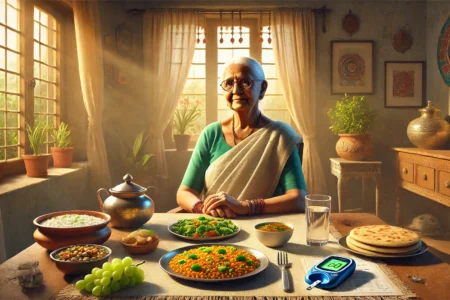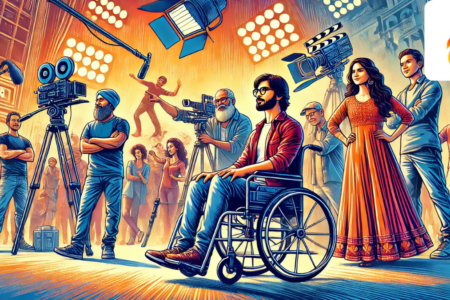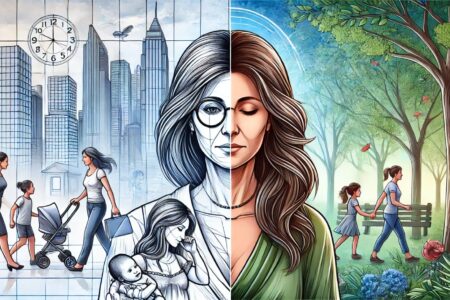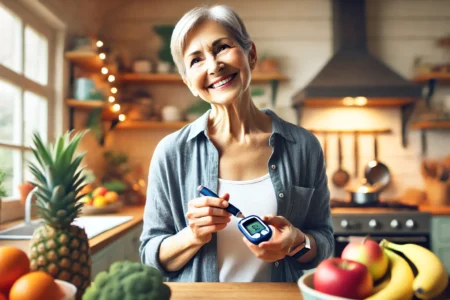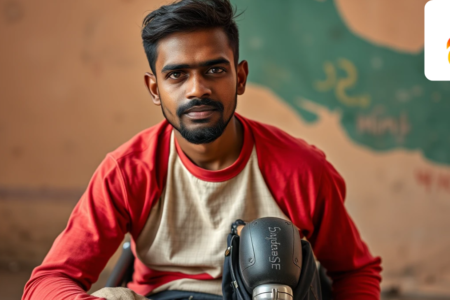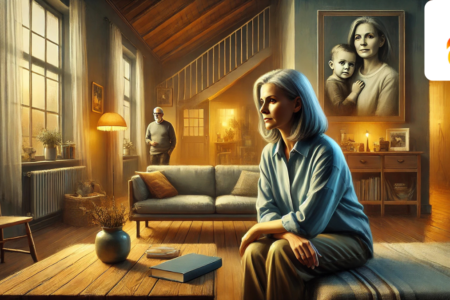In part one we discussed the emotional landscape of diabetes in senior citizens from the initial shock of diagnosis to the small, meaningful steps toward self-care. Today, in part two, we’ll discuss in-depth the challenges senior citizens face when managing diabetes. The first step in this journey begins with one vital factor, and that is curiosity and commitment. If you are reading this it means you have already started the process and that’s the spirit we need to embrace every challenge that diabetes imposes. But let us be honest challenges, stubbornness, and refusal to adapt, can feel like walls. The good thing is they are walls that can be scaled, one layer at a time. So let’s tackle these obstacles, not just with practicality but with a sense of purpose and self-love. Physical Challenges: When Your Body Feels Like a Stranger Imagine waking up every day with the knowledge that your body no longer works as it once did. For elderly people with diabetes, getting out of bed can be sore, tiring or sting with the feeling of neuropathy. And to be able to get past that, for them, it is where the challenge lies. To feel in a body that has seemingly stopped working is harsh, and it is what they have to go through on a daily basis. But the physical pain is just the beginning. Let’s discuss 0about the emotional toll. Diabetes is an unrelenting disease, requiring constant vigilance and lifestyle management. For senior Citizens, with diabetes develop Peripheral neuropathy and high blood sugar along side, both of which are far too common in the elderly. Feeling pins and needles, burning sensations, and losing the sensation in hand and feets are but some of the sensations that they have to endure; walking, holding objects and even temperature changes painful, and with it, the chances of falling and injuring themselves greatly increase. Mental Health Struggles and Unspoken Grief Let’s not forget about the mental health struggles that come with the territory. Depression and anxiety are prevalent among seniors with diabetes. The constant need for vigilance, combined with physical pain and social isolation, creates a fertile ground for emotional distress. Many seniors feel invisible—their struggles overshadowed by the general assumption that aging itself is to blame for their difficulties. But diabetes isn’t just a side effect of aging; it’s a relentless force that demands attention and care. And then there’s the unspoken grief. For many seniors, diabetes feels like a thief that’s stolen the life they once knew. Dreams of a carefree retirement, filled with travel and leisure, are often replaced by endless doctor’s appointments and the grind of managing a chronic disease. It’s not just the physical limitations; it’s the emotional weight of adjusting to a new normal that feels anything but normal. Financial Strain: The Hidden Cost of Care Financial strain is another burden that often goes unnoticed. Managing diabetes isn’t cheap, and for seniors on fixed incomes, the costs can be devastating. Between glucose monitors, test strips, insulin, medications, and regular doctor visits, the expenses add up quickly. Many seniors face the impossible choice of prioritizing their health or meeting other basic needs, such as food or housing. Financial insecurity can worsen blood sugar control, creating a vicious cycle. For some, diabetes is not just a thief of health but a strain on relationships. Family dynamics often shift as adult children step into caregiving roles, sometimes reluctantly. This can lead to resentment on both sides the senior may feel like a burden, while the caregiver might feel overwhelmed. Marital relationships can also be strained, as partners adjust to new caregiving responsibilities that often come with diabetes. The Fear of Isolation Diabetes can be a kind of disease that can alienate many senior citizens. It’s not something new to feel that your family and friends don’t know what you’re struggling with. Attending parties often turn out to be a barrage of ‘whys’ and ‘explanations’. “Why aren’t you trying the cake? You always loved the cake!” Well-meaning but frustrating, isn’t it? Wrapping Up: Your Story, Your Strength Diabetes is not your defining chapter; it’s a subplot in a story of resilience, courage, and transformation. You’ve faced countless trials before and emerged stronger. This is no different. So, as you move forward, keep this in mind: you are not alone, and every step you take is a testament to your strength and spirit. In the third part, we’ll discuss the solutions to thrive with diabetes, surrounded by care, knowledge, and love. Until then keep reading foramz for your daily dose of emotional support.
Last week we talked about how loneliness in youth can result in habits of smoking and vaping. To get into the root of the issue it is important to understand what leads to the youth’s attention drifting in the direction of such habits. You might have noticed how vaping and smoking have become common among the youth. Whether it’s at a house party, during a break at school, or even scrolling through social media, it’s everywhere. But have you ever wondered why are we turning to these habits? What is it that we are looking for in that puff of cigarette? It’s not always about looking cool or rebelling. For a lot of people, it’s about filling a void—loneliness, stress, or just trying to feel like we belong somewhere. Let us talk about the reasons one by one. The Weight of Loneliness Loneliness is a word that creeps at us. The feeling is not always obvious, but it’s there, creeping in late at night when we’re mindlessly scrolling through Instagram or TikTok. We see everyone else having fun, going to parties, traveling, and living their best lives. “But what about me?” A question that leaves us feeling lonely or in today’s language FOMO, we experience the fear of missing out. We feel left out like we don’t measure up or “fit in.” It’s a terrible feeling, right? And that’s when the idea of a quick escape—a vape pen or cigarette—starts to look tempting. For a moment, it feels like it takes the edge off, like it’s giving you a break from all the noise in your head but tragically, its adding on to that void. Trying to Fit In We’ve all been there—that moment when you’re hanging out with friends, and someone offers you a vape. You don’t really want to, but saying “no” feels impossible. You don’t want to seem lame or risk being left out. It’s tough because fitting in feels so important, the fear of being alone is so prominent that you take a puff. It’s not always about enjoying it; it’s about belonging, even if just for a moment. The Circle of Expectations Life can be stressful, even for youth. Between school, grades, extracurriculars, and trying to figure out what you want to do with your life, it feels like the weight of the world is on your shoulders. In reality, it is not but the age, the surroundings, and societal pressure make us feel that way, which is completely natural. Add in the pressure to have a happening social life, look good, and keep up with everyone else, and it’s enough to make anyone crack. But vaping or smoking might not be the lifeline you are looking for. Vaping or smoking might feel like a way to take a breather, to calm your nerves. But the truth is, that relief doesn’t last. It’s just a temporary band-aid for a much bigger wound. Family and Emotional Struggles In some cases, the problem starts at home. Maybe your parents are too busy to notice what you’re going through, or maybe they just don’t get it. You feel invisible, like no one really understands or cares. Picking up a vape or a cigarette might feel like a way to take control, to do something for yourself. Or maybe it’s a way to say, “Hey, I’m hurting.” But here’s the thing: you’re not invisible, and people do care, even if it doesn’t feel that way right now. Things do change. The Hold of Marketing Have you ever noticed how vaping is made to look so cool? Flavors like mango, cotton candy, grapes, and mint—they’re not targeting adults; they’re targeting youth. The ads make it seem harmless, even fun and cool. But the reality is that these companies are selling them intentionally by promoting them as a “safer option” than cigarettes, which is totally a myth. Nicotine is one of the main ingredients in vape. It has harmful chemicals which can cause lung diseases and even cancer. The companies, just want your money. And once you’re hooked, it’s hard to stop. That’s how they win. Don’t let them. You’re Not Alone If you’re reading this and somewhere resonate with it don’t worry you are not alone. There are so many people out there who feel the same way you do. The world can be tough, and it’s okay to struggle. What’s important is that you don’t give up on yourself. You are worth more than a vape pen or cigarette. You’re stronger than you think, and you have an entire life to live full of possibilities. Do not let that temporary escape steal that from you. Stay strong, and remember you’ve got this. Here’s the truth: vaping and smoking won’t fix the loneliness, the stress, or the pressure. They might distract you from the pain for a little while, but in the long run, they’ll only make things harder. Addiction, health problems, guilt—none of that is worth it. So in the next week, we will see in detail how can we healthily cope with these emotions. Because you are not alone. Keep Reading Foramz for you daily dose of moral support.
In the last week, we saw the state of disabled people and their conditions in Bollywood. Bollywood is an industry where making your name is already a challenging feat. As an aspiring with a disability, it becomes testing to bag a trusting job in Bollywood. Known for its unpredictable and risky job stigma, Bollywood became a place where most people with networks make it easily. Despite India being home to over 26 million people with disabilities (According to the 2011 census), people with employment in Bollywood are scarce. The portrayal and treatment of disabled individuals in Bollywood has been a contentious issue, reflecting border societal attitudes and systemic problems. To resolve any social issue, it is important to understand exactly what are the issues faced by people with Disabilities. This is Foramz and today we will discuss the issues with the handicapped or specially abled in Bollywood. Typical Sympathy portrayal. If you notice, disabled characters are often depicted as objects of pity, charity, or inspiration which reinforces harmful stereotypes. Society is largely influenced by cinema, hence, we end up forming their image as people who need pity or charity. Are they not capable of achieving complex feats apart from their disabilities? Absolutely no. People with disabilities are prone to have more willpower and dedication. Films like Black and Paa revolve around disabilities but are often romanticized or exaggerated to create dramatic effects. Lack of Authentic Representation. Behind the scenes, the film industry remains inaccessible to disabled professionals due to infrastructural, cultural, and attitudinal barriers. Imagine, not being able to find a job because you faced an unfortunate accident. t a feeling of utter helplessness. Despite that, people with disabilities rise from their physical flaws and dare to soar but practical difficulties come in their way. The film Industry remains a space where opportunities are plenty but grabbing them is a challenging task. There are limited opportunities for disabled actors, writers, directors, or crew members. After waiting in line for hours, calling and pitching countless times, there are instances that the filmmakers do not prioritize people with disability regardless of their talent. They have a mindset that it is taxing to work with people with such disabilities. It is important to notice that they deserve a chance too. It is not only about chance, it is about the life and future of an individual. Insensitive Humour Bollywood is incomplete without comedy movies, but there are times when the jokes become insensitive and normalized behind an ethically faulty dogma. For instance, in Housefull 3, the male protagonist is faking various disabilities such as blindness, muteness, and paralysis to gain sympathy and manipulate others. This creates a slapstick comedy out of conditions faced in real life. Such portrayal makes the audience believe that people with disabilities are people who crave sympathy instead of empowerment. This insensitivity towards disability not only normalizes ridicule but also undermines efforts to foster respect and understanding towards disabled communities. It is simple, imagine a person giving you words of sympathy, like it’s okay or you will be fine when you are completely fine. It will make you question yourself whether you are fine or not. The same is true in this case, Disabled communities do not need sympathy because they have accepted their condition. Inaccurate Storytelling Disablities are often poorly researched and misrepresented which leads to misconceptions in people’s minds. Thereby forming a different perception of them and treating them accordingly which is far from reality. For instance, mental health conditions are sometimes dramatized in ways that are not completely true or lack information. This stigmatizes those who experience them. The issues lie in perception. If the way society thinks of them does not change, their issues will never be completely resolved. It is important to see them as they are without forming assumptions about their condition. Prejudice and Discrimination Casting directors and Filmmakers may hold biases believing disabled people might not be capable of fulfilling roles or demanding higher accommodations. Many in the industry prioritize physical perfection and conventional beauty standards which marginalize disabled artists. It is important to acknowledge their talent. Society expects picture-perfect handsome and beautiful actors on-screen which creates unseen expectations for the filmmakers. This results in limited opportunities for disabled people to make it on-screen. Behind the Camera Scenes Jobs like direction, editing, scriptwriting, and production often require long hours of work and are physically demanding work environments. This factor may not be welcoming disabled professionals. The lack of mentorship programs or training initiatives adds up to the issue. Even disabled professionals need training and the right guidance to thrive as much as a healthy-bodies professional needs. Behind the camera, jobs have more people in line. hence, the competition is fierce but there are instances where disabled professionals don’t get a chance to show their skills. Economic Instability Bollywood is a highly competitive and informal market where networking and connections secure jobs and opportunities. Connections and networking often outweigh merit and talent. Disabled individuals lack access to these connections and networks further reducing their chances to reach their professional goals. Studios may perceive accommodations as an additional expense which discourages them from hiring disabled professionals. The issue lies in the roots of the people’s perception. To foster inclusivity and equal opportunities for everyone it is essential to understand disabled individuals. It is important to not judge on their disabilities and to have an open mind while hiring. In the next week, we will look at real-life examples of people with disabilities and how they face struggles and rise with immense willpower. Keep Reading Foramz for your daily dose of moral support.
Last week, we talked about how women experience changes in their lives. The struggles that Middle-Aged women go through during their growth are an untouched topic. There are various stages of change in a growing woman. The biggest transition occurs in the Middle-Age phase. Middle age is often referred to as a bridge between youth and old age. A stage where 2 personalities coincide, bodies transform and the mind is on high alert about the newly coming transformations. For women, this period is typically defined as the years between 40 and 60. Imagine being a mother who has spent all her life looking out for the family and is now feeling isolated as the children have grown up and have to work as it is their time to strive. In this case, these feeling of isolation is heightened by menopause and other factors. In this blog, we will be discussing all such issues that these strong women experience in middle age in detail so we can help understand them better and empathize with their feelings. Emotions all over the place with Menopause Menopause typically occurs after the age of 40. In simple words, menopause is a process where the ovaries stop producing eggs. Due to this biological halt, hormone levels decrease. As hormones are responsible for regulating emotions in our bodies, their sudden decrease results in emotional distress, mood swings, weight gain, and sleep disturbances. On top of this biological outburst, many women go through a transition in life. Middle age coincides with children leaving home for college or careers. While this is a natural phenomenon, women can feel lost and purposeless. After years of comforting, nurturing, teaching, and scolding a child becomes capable of taking an independent step toward their own life and when the child is finally ready a mother may naturally feel lost without the child. This phenomenon is termed “empty nest syndrome” This sudden change in their daily routine leads to a feeling of loneliness which is never really addressed. Naturally obliged to be selfless the middle-aged woman does not think of it as important of an issue to be addressed. But we should know and notice this and lend an ear sometimes. Middle Age is a stage where women often question their own life choices if they have lived up to their potential. Balancing the roles of mother, partner, professional, and individual can create a sense of overwhelm. As a woman feels torn between fulfilling societal expectations and pursuing personal dreams. Always looking out for others, the woman forgets of her aspirations. The Physical Transformation. Physical changes that Middle-Aged women experience are inevitable and distressing, especially in a society that considers the perfect face, skin color, and hourglass body shape as a beauty standard. Menopause brings with it a host of physical symptoms including hot flashes, night sweats, fatigue, and joint pain. These symptoms disrupt their daily routine paired up with the societal pressure of “keeping it together”. No matter what goes inside the body, women are expected to be calm and composed and undertake their routine professional or household tasks smoothly. This is an unseen pressure from societal standards where issues like menopause have not been discussed enough. Many individuals fail to even know about it. Biologically, aging women experience weight gain due to gradual metabolism, hormonal changes, and a decrease in physical activity. This affects their self-esteem, especially in a culture that glorifies slum, youthful figures. With age women face an increased risk of health issue such as osteoporosis, heart disease and breast cancer. Regular health check-ups and preventive care become crucial, but many women neglect their own health due to caregiving responsibilities or financial constraints. Professional Challenges Middle-aged women in the workforce encounter unique challenges. Women in their 40s and 50s often find themselves overlooked for promotions as companies prioritize younger talent under the guise of “fresh ideas.” Their years of experience and wisdom are undervalued and their contributions remain overshadowed by stereotypes that portray middle-aged women as being addicted to technology. For women who took a career break to raise children, re-entering the workplace becomes an uphill battle. The gap in their resumes is often viewed as a liability and they face challenges coping with the evolving job market. Many middle-aged women juggle professional responsibilities with caregiving roles, whether for aging parents or depending on children. Their switch from a strong and bold employee or leader to a gentle caring daughter or mother is commendable. But these switches cause a mental and Physical toll which often leads to burnout. Social Isolation and Loneliness As a woman ages, she loses friends and he social circle shrinks due to various reasons like busy schedules, geographic relocations, or differing life stages. This leads to feelings of isolation and loneliness which is exacerbated by societal invisibility that Middle-Aged women experience. In the Modern world which is obsessed with youth, Middle-aged women often feel ignored. Advertisements, media, and popular culture rarely represent women in this age group, reinforcing that their best years are already behind them. In some cases, age brings strain in marital relationships as couples face midlife crises, empty nests, or financial pressures. Divorce rates are high among middle-aged couples, leaving many women to navigate this phase of life alone. Financial Problems Financial challenges are a significant concern for middle-aged women, particularly for those who took a break from work to focus on families, many women enter middle age with insufficient retirement funds due to career break or lower-paying jobs. This creates anxiety sense of fear about their future. Eventually, this anxiety becomes a full-grown fear of being a burden to their family. Women who rely on their spouses for financial support face vulnerability. This is prevalent in cases of divorce or the death of a partner. Without personal savings or financial literacy, they may struggle to secure their independence. Cultural and Societal Shackles. Cultural norms and societal expectations add another layer of complexity to the lives of middle-aged women. Society expects women
Puberty brings about unique and new changes, it serves as a significant transformation that marks the end of one chapter of life and the beginning of another, for girls it is a struggle and an exciting thing to experience as it is more of a transition from being a girl to becoming a woman. It’s a period of growth emotional, mental, and even physical. Imagine us having a heart-to-heart conversation because that’s exactly what this article aims to be a guiding light, a comforting hand, and a voice saying, “You’re not alone.” What Is Puberty, and Why Does It Happen? First things first: what is puberty? puberty is how the body prepares itself for adult life. Puberty is the part of the transition where one starts to have an increase in hormones, for example, estrogen, which comes through the body and can feel like an avalanche most of the time. It’s nature’s way of molding and shaping you into an astonishing person. But yes, it can be confusing, and that’s okay. The Physical Changes: A New Chapter for Your Body One of the first signs of puberty in girls is growth spurts, especially among young girls, so it wouldn’t surprise you if you woke up one day feeling significantly taller! Your body will also reshape into the classic adult body, where the hip area will broaden. It’s just your body’s way of adjusting to its new role. And then there’s your period. Ah, the big one. It comes with being a woman – your reproductive system is ready to function. While it can be scary at first “What am I supposed to do with these pads and tampons?”—trust me, it becomes second nature before you know it. Emotional Changes: Riding the Rollercoaster If puberty feels like a wild rollercoaster, it’s because it kind of is. Your hormones are surging, and that can make emotions feel more intense. One moment, you’re on top of the world, and the next, you’re feeling sad for no specific reason. This mood fluctuation is perfectly okay. It’s fine to cry, it’s fine to laugh and it is fine to feel everything in between that because it is part of getting older. You may also crave a fuller sense of independence and try to form your own identity. It is natural to feel the desire for some space to understand yourself better and your core values. Just remember to communicate with your loved ones. They’re learning how to adapt to the new you too. How to Cope with These Changes Navigating Friendships and Social Dynamics Along with growth, puberty affects friendships and social groups as well. You might outgrow certain friends or feel the urge to fit in. Remember, true friends, accept you for who you are. Don’t be afraid to set boundaries or walk away from negative influences. Surround yourself with people who uplift and inspire you. The Importance of Positive Role Models Having someone to look up to can make all the difference. Whether it’s a family member, teacher, or public figure, a positive role model can guide you through the ups and downs of puberty. They’ve been through it, and they survived. So will you. You’re Stronger Than You Think Puberty is a journey, not a race. There will be days when it feels like too much, and that’s when you need to remind yourself: this is temporary. Every challenge you face is shaping you into a stronger, wiser, and more compassionate person. You are becoming you. So take a deep breath and give yourself grace. Celebrate the small victories — surviving a tough day or figuring out how to use a new type of period product. You’ve got this. And remember, you’re not alone on this journey. Millions of girls have walked this path before you, and millions more will after you. You are part of an incredible sisterhood. Welcome to the club. For your daily dose of emotional support keep reading Foramz.com
Unspoken hurdles of men multi-tasking In this generation, everything is so fast-paced life goes on way faster than we expect, everyone has a tough life excelling in this generation, gender roles and gender tasks have changed from indoors to outdoors through modern ideologies but still many are stuck in between, however, the roles of men have evolved drastically throughout the years along the traditional boundaries society has created. Traditionally men have been known to be the breadwinners of the family, also known as the husband, father, brother, and again supposedly breadwinner. Now as we study gender roles being equal in terms of modern-day tasks indoors and outdoors, balancing this whilst in a family could be a monumental task as society expects them to navigate these issues and hold the responsibility by themselves keeping the vulnerability deep inside hiding beneath a precepting cover, having the seamlessly without complaints, where the struggles of men striking a balance between professional and personal lives are often hid behind a veil. Men often have these stoic expressions and unwavering negative commitments that hide unspoken hurdles that raise questions of unasked doubts, which also causes emotional distress, strains that are rarely disclosed in public. Men are often caught in a paradox where men are encouraged to be emotionally available while they are engrossed in work, and societal expectations are often shaped in a way that leaves very little room for their expressions of certain classified emotions. This little room also has created a stereotype where very few people can accept their errors and mistakes and are often reimbursed as a bigger one. This will focus on the unique aspect of multitasking with different facets of life focusing on the emotional weight of fatherhood to the pressure of workplace performance from a loving partner to maintaining familial bonds as a brother and a son, through real-life struggles aiming to break silence on men’s struggles and celebrate their resilience. This series will challenge outdated stereotypes, foster empathy, and open doors of inclusivity and supportive narratives in the sphere of masculinity where also aims to dig into the root cause and explore the unspoken facts of the real world the men face in everyday life, while these men strive to multitask across different spheres of this little life, from juggling deadlines at their workplace to having moments of self-doubt, exhaustion, being a supportive partner and an engaged parent, unable to be able to share this burden with anyone having the perception of misconduct and being judged due to the societal pressure. With this series, we will unveil as we explore and talk more about the role of men in everyday lives by discussing their challenges, sacrifices, and triumphs which shape the lives of the family members, about how men fight and celebrate their resilience as they navigate the complexities of this modern life with the part of the sphere they live in and confine all of this together. This is not just an exploration but also a tribute to strength who stand with the ones who need, keep up with adaptability and quiet determination, Welcome to the journey of understanding empathy and empowerment. For more updates keep following foramz.com
Each morning, rejuvenating your health becomes quite straightforward knowing that all the decisions you make will help you achieve that. For people in their old age, simply getting informed that they have diabetes can be a major shift in the journey they are traveling. But what if this challenge is also an opportunity? Diabetes is not just a medical condition; it’s a new way of understanding and nurturing your body. It’s natural to feel a wave of emotions fear, frustration, determination, and even gratitude as you adapt to this new reality. But here’s something crucial: every move you make towards dealing with your diabetes is a courageous and self-loving step. It is entirely in your hands how you want your journey to pan out, The type of decisions you make while being healthy can help determine that as well. A Soft Beginning: Understanding the Emotional Side of Diabetes Let’s face it: hearing the words, “You have diabetes”. You are probably recalling this very moment. It may have caused a flood of questions, like “What does this imply for my future? What alterations should I expect in my life? Can I still enjoy the things I love?” And those questions might have been accompanied by emotions that felt just as powerful. And those questions might have been accompanied by emotions that felt just as powerful. You might have felt a pang of fear for the future, a wave of frustration about the changes you’ll need to make, or even a sense of sadness for the ease of life before diabetes. Reflections on Care: a New Approach to Compassion Self-care entails positive reinforcement, especially for senior citizens who have been diagnosed with diabetes. But self-care isn’t just about deprivation or strict adherence to rules, it’s about honoring your body and mind with compassion and consistency. Take a moment and think about the things you have done so far in your life. You have been through the good and the terrible although being blessed with an array of experiences. Managing diabetes is another opportunity to show the strength you’ve gained over the years. You are not looking for flawlessness instead tiny bites are more than enough. Every single step you take whether it’s choosing to learn to check your blood sugar levels, a healthier meal, or going for a gentle walk is a victory worth celebrating. The Emotional Shifts Many senior citizens initially feel a sense of loss when diagnosed with diabetes. It’s okay for them to shed a few tears when they first discover that they are diabetic, as grief can be an essential phase of acceptance. Normal activities that one once enjoyed, such as eating candy at a family function or being lazy and not wishing to go for a walk in the rain, have been lost alongside their condition. But is it necessary for any of these to feel like a loss? Looking Ahead A chronic disease such as diabetes shouldn’t be thought of as a label, it is only a fraction of your entire life. In the next part, we’ll look into the common challenges seniors face while managing diabetes and how to overcome them with practical solutions and support. But for now, take a deep breath and know this: you’re capable, you’re strong, and this is just the beginning of a healthier, happier chapter.
In today’s tech-savvy world, where everyone and everything you need is just a click away, a surprising paradox has emerged. Despite all the means to talk to whoever you wish to, today’s youth lacks communication and are left deeply lonely and isolated. This sense of loneliness is exacerbated by societal pressures, academic stress, and limited face-to-face interactions. This is Foramz and today we will be discussing Loneliness and how the youth copes with it. Being alone turns out to be quite a common fear to people. Loneliness is a distressed emotion that anyone can feel. The person in question today is Youth. Bestowed with the blessing of technology and social media the youth is expected to be happier than ever, being more connected than ever, but the reality is quite shocking and contradictory to what should have happened. From a young age, society teaches them that their worth is tied to their achievements, appearances, or social status. They strive to meet the expectations of parents, teachers, and peers, yet often feel they are never enough. The fear of failure haunts them, and even when they succeed, the satisfaction is fleeting—quickly replaced by new challenges and doubts. Loneliness is a shadow that looms over the psychological state of youth. Despite constant digital interactions, many feel disconnected from those around them. They scroll endlessly through feeds filled with others’ highlights, comparing their behind-the-scenes struggles to the carefully filtered lives of their peers. This comparison feeds a growing sense of isolation, convincing them that they are the only ones struggling. The result is a deep emotional void that leaves them longing for authentic connection but unsure of how to seek it. There are several factors affecting the loneliness that today’s youth face. Some factors are making them more lonely and depressed one of them being the consumption of intoxicants like smoking, alcohol, vaping, and drugs. Today’s youth has the freedom to talk for hours on Instagram but have lost belief in real-life heart-to-heart conversions. Family disputes, issues with parents, inferiority complex, the feeling of being ‘not good enough’ The screen has become a mental prison and the youth its prisoners. Loneliness can have a significant impact and the mental and emotional well-being of an individual. There are many healthy ways to deal with loneliness and young individuals coping mechanisms. Coping mechanisms are a strategy to manage difficult or unpleasant emotions. Unfortunately, some resort to unhealthy habits like smoking and vaping as a way to deal with their feelings of not belonging anywhere. It is quite natural to feel that you don’t belong anywhere at a certain point in time in life. These habits often provide temporary relief or belonging, but looking at the broader view, these toxicants only make an individual more lonely. Vaping, in particular, has become increasingly popular among youth, marketed as a “safer” alternative to smoking. Its appeal lies in its accessibility, flavored options, and its perceived trendiness. However, both smoking and vaping pose serious health risks, including respiratory issues, addiction, and long-term damage to the lungs and heart. There are common myths related to vaping that they are safer and better than smoking cigarettes. Such myths are used as an explanation or excuse for continuing the habit. The real problem lies in the psychological distress which they are going through. It is essential to address the issue of loneliness instead of being trapped in the vicious cycle of vapes and cigarettes. Addressing this issue requires fostering genuine connections and providing support systems for people. Encouraging open conversations about mental health, promoting healthy coping mechanisms, and building inclusive communities can help combat loneliness and reduce the reliance on harmful habits like smoking and vaping. In the next week, we will be discussing in-depth how young minds resort to such toxicants and understand their psychological state. Keep Reading Foramz for your daily dose of moral support.
Bollywood is also known as a destination where dreams are created. The glamorous world has tremendous opportunities to offer from fame, and power to a creative platform for expression, it is all an individual could ever dream about. But are these opportunities accessible to everyone in the country? This is Foramz and today we will talk about how Physically disabled people struggle for an opportunity in the so-called hub of dreams- Bollywood. While there has been a gradual shift of the dreamland towards inclusiveness and diverse representation in cinema, the opportunities for people with disabilities remain limited as these passionate and determined individuals live in the hope of a better future. This disparity stems from societal prejudices, lack of infrastructure,, and stereotypes in storytelling. Bollywood as an industry is widely versatile and have varied job profiles available. Despite such a large vacancies, people who are handicapped yet talented fail to get the opportunity that they deserve. Call it biased society or the authorities mindset of underestimating the talent, it is a social issue which ruins talent and lives. Mumbai the city of dreams, promises hope, fame and money to all but the one who had the courage to leave their hometowns, families and make a career in the city that never sleeps now know why the city never sleeps. It is because the city keeps the dreamers awake, awake until it is dawn and have to work again, awake in thoughts of survival, awake in the memories of their families, awake in the worry of an unmarried sister, awake in the stress of getting the role, awake in striving for that position, awake in proving their worth. People privileged with their healthy bodies do strive but people with physical liabilities have to strive harder. People who don’t have a prosthetic leg work hard but people with a prosthetic leg face issues in walking hard. The difference is that they face great hurdles in performing day to day tasks with ease. Bollywood is well known as a place uninviting for outsiders. People with contacts and networking can get opputunities but people who become handicapped in a tragic incident do not have contacts. Does that mean that they will live a life full of false hopes and sympathies ? Obviously No ! Such people do lose an ability but have mental strength like any other. Their will power is strong but no one can survive in Bolywood only on will. Albeit portrayed by a non-disabled actors, films have been released which depict the struggles of disabled individuals. Advocacy groups and disabilty rights activists push for more inclusivity in casting, scriptwriting and production. Yet the progess remains slow and sporadic which reefelcts socety’s attitides towards disability. Behind the scenes, the hurdles are no less daunting. Basic amenities like wheelchair access, assistive technologies, and supportive work environments are often absent, making it harder for disabled individuals to fully participate in the industry. Lets assume somehow they do get a meaningful opputunity but later, they are bound to face widespread stigma and are often typecast or sidelined, without opputunities to meaningful roles or opputunities. To transform the state of handicapped individuals in Bollywood, systemic reforms are essential. These include proactive casting of disabled actors, making production environments more accessible, and challenging stereotypes through thoughtful and accurate storytelling. Only then can Bollywood become a truly inclusive industry that values talent and creativity over physical abilities Societal attitude towards disabilities compound a problem. There is a perception that individuals with disabilities are less capable of performing more demanding tasks associated with fimlmaking, whteehr on screeen or behinf the camera. This misconception has pushed the opputunities in another direction leaving such talented people without a chance to prove them. All they need is a chance to prove themselves Furthermore, societal attitudes compound the problem. There is a perception that individuals with disabilities are less capable of performing the demanding tasks associated with filmmaking, whether on screen or behind the camera. This misconception fosters an environment where handicapped individuals are overlooked or underestimated, irrespective of their skills or qualifications. This was a glimpse in the life of people with disabilities and their struggles to make it in the bollywood industry. Next time we will be discussing depth about how these struggles are a part of a larger social issue. Keep Reading Foramz for you daily dose of moral support.
When we think of women, we typically think of their roles as women. Our imagination leads us to a caretaker and a nurturer. The definition and roles of women have evolved over the years. Typically before modernization, women were confined to the home, as time evolved and the thinking broadened, women and the people surrounding them gained a perspective that they too are meant for bigger roles outside of the home. If you ask a 90s kid today how your parents managed the house and ask contemporary couples about the same, the answer will vary. The ’90s kid might say that their father earned money and their mother cooked food, their father taught practical subjects like maths and science while their mother instilled values and morals. While Dad looked after our bike and car, Mother looked after the house. All the tasks were divided according to the general capability of the fellow parent. As urbanization and modernization took over the globe, these dynamics have shifted to both parents coming home to household chores. In this fast-paced world, work does get hectic, it becomes difficult to manage both house and work at the same time. This is when couples end up having a helper, cook, and car to travel to work making life a little easier but does it? When a family does not have enough funds for such comfort and luxury the pressure naturally comes on the woman of the house to cook, clean, and manage the household and domestic relationships. Not because the people surrounding them are forcing them to do it but because that has been their natural role from the start of the human race. But contemporary times require balance. Now you may wonder what is the problem here. As a woman ages, she goes through certain biological changes that affect their emotions and how they react to situations. In a broader view, certain circumstances and instances lead to various psychological issues such as chronic stress, weak self-image, self-doubt, depression, insomnia, postpartum depression, and existential crisis. Aging plays a pivotal role in these psychological changes. Aging is an inevitable process that we all embark upon. As for women, the passage of time comes with several sets of hurdles often amplified by societal expectations, stereotypes, and deeply ingrained biases. The Emotional Rollercoaster One of the most common struggles women face as they age is an identity crisis. For years, their identities are often intertwined with the social roles they play. Imagine a woman who is newly married, shy, and anxious about her future in the new home. With thoughts racing for her parents and an unseen pressure of doing good in a new home. Fighting, striving through her thoughts she somehow manages to make the new home her own. But that is not where problems end. Soon family hints at the need for an heir and her typical role is to be fulfilled. Unsure of her capability, the young woman agrees to have a baby and bravely sustains the excruciating pain of rearing a child. The struggle of 9 months, uncontrolled urination, extreme mood swings, and not being able to eat anything or take medicines, and the society’s pressure typically seen in Inida of rearing a male child. After bravely, sustaining all this comes postpartum depression which not many are even aware of. Society seems to ignore the emotional turmoil that comes after giving birth. After breaking almost The problem arises when the woman of the house puts everyone and everything before her and loses her own identity as an individual. As children grow up and careers plateau, many women feel the emptiness creep in. For years their life purpose has become to cater to others’ needs, and they forget how to live for themselves. This is when reflecting upon the self becomes the most important. A complimentary aspect affecting psychological issues is the hormonal fluctuations in a woman. The Physical Wave Aging brings inevitable physical and biological changes. Some of them include wrinkles, gray hair, stretch marks, weight fluctuations, and declining energy levels. It is often heard that after the age of 30 women’s bone density decreases and that’s when knee aches start. Declining estrogen levels, especially during perimenopause and menopause, accelerate this loss as estrogen plays a crucial role in maintaining bone density by regulating bone breakdown. Imagine shouting at your son for no reason as such and getting in a dispute only to feel guilty later on. Being in a confused state of helplessness and not knowing what you are facing and why you are facing it. That is Menopause. According to psychologists, Menopause is the most crucial stage in a woman’s life. The age group in this transition is 40 to 65 years of age. Menopause brings a variety of changes- hot flashes, mood swings, weight gain, sleep disturbances, and a decrease in bone density which impacts not only the physical but emotional well-being of the woman. Alongside, this is the age where there is a diverse array of changes taking place such as health concerns, family problems, work-related issues, deaths, frustrated goal attainment, and financial worries. Professional Challenges In the workplace, aging women face various challenges as men in their 50s are considered wise, and experienced women of the same age are deemed “past their prime.” This bias hinders advancement, leaving many women stuck in mid-level positions or facing forced early retirement. For example, a 50-year-old marketing manager may be passed over for a promotion in favor of a younger colleague, despite her extensive experience. The assumption that older women are less adaptable to technology or modern trends is not only incorrect but also deeply unfair. Loneliness and Isolation As women age, their social circle often shrinks. Friends move away or a busy with their own lives and for some, widowhood brings a profound sense of isolation. Society rarely addresses the loneliness that women endure leaving many to cope alone. Women who have no access or little access to social circles end

